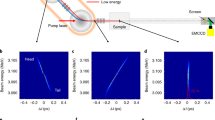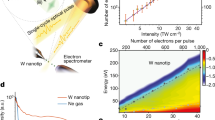Abstract
Recording electronic motion in atomic systems requires attosecond and picometre resolutions. Current attosecond technology provides photon pulses up to an energy range of 100 eV, with wavelengths far too long to access structures on the atomic scale. In contrast, ultrashort free-electron pulses with sub-Ångstrom de Broglie wavelengths offer the potential to resolve sub-atomic structures. Here, we demonstrate an optical-field-driven streak camera for their temporal characterization. Our concept is to have an electron beam and a laser beam intersect at an ultrathin metal mirror, and potentially offers attosecond resolution. The technique will be instrumental in advancing ultrafast electron diffraction towards ever higher temporal resolution in the pursuit of the long-term goal of sub-atomic four-dimensional imaging. As a first application, we study the influence of electron–electron interactions on the characteristics of few-electron pulses.
This is a preview of subscription content, access via your institution
Access options
Subscribe to this journal
Receive 12 print issues and online access
$209.00 per year
only $17.42 per issue
Buy this article
- Purchase on Springer Link
- Instant access to full article PDF
Prices may be subject to local taxes which are calculated during checkout





Similar content being viewed by others
References
Hentschel, M. et al. Attosecond metrology. Nature 414, 509–513 (2001).
Drescher, M. et al. Time-resolved atomic inner-shell spectroscopy. Nature 419, 803–807 (2002).
Niikura, H. et al. Probing molecular dynamics with attosecond resolution using correlated wave packet pairs. Nature 421, 826–829 (2003).
Itatani, J. et al. Tomographic imaging of molecular orbitals. Nature 432, 867–871 (2004).
Niikura, H. et al. Sub-laser-cycle electron pulses for probing molecular dynamics. Nature 417, 917–922 (2002).
Baker, S. et al. Probing proton dynamics in molecules on an attosecond time scale. Science 312, 424–427 (2006).
Smirnova, O. et al. High harmonic interferometry of multi-electron dynamics in molecules. Nature 460, 972–977 (2009).
Meckel, M. et al. Laser-induced electron tunneling and diffraction. Science 320, 1478–1482 (2008).
Blaga, C. I. et al. Imaging ultrafast molecular dynamics with laser-induced electron diffraction. Nature 483, 194–197 (2012).
Flannigan, D. J. & Zewail, A. H. 4D electron microscopy: principles and applications. Acc. Chem. Res. 45, 1828–1839 (2012).
Sciaini, G. & Miller, R. J. D. Femtosecond electron diffraction: heralding the era of atomically resolved dynamics. Rep. Prog. Phys. 74, 096101 (2011).
Shorokhov, D. & Zewail, A. H. 4D electron imaging: principles and perspectives. Phys. Chem. Chem. Phys. 10, 2879–2893 (2008).
Chergui, M. & Zewail, A. H. Electron and X-ray methods of ultrafast structural dynamics: advances and applications. ChemPhysChem 10, 28–43 (2009).
Hebeisen, C. T. et al. Femtosecond electron pulse characterization using laser ponderomotive scattering. Opt. Lett. 31, 3517–3519 (2006).
Hebeisen, C. T. et al. Grating enhanced ponderomotive scattering for visualization and full characterization of femtosecond electron pulses. Opt. Express 16, 3334–3341 (2008).
Van Oudheusden, T. et al. Compression of subrelativistic space-charge-dominated electron bunches for single-shot femtosecond electron diffraction. Phys. Rev. Lett. 105, 264801 (2010).
Siwick, B. J., Dwyer, J. R., Jordan, R. E. & Miller, R. J. D. Ultrafast electron optics: Propagation dynamics of femtosecond electron packets. J. Appl. Phys. 92, 1643–1648 (2002).
Lobastov, V. A., Srinivasan, R. & Zewail, A. H. Four-dimensional ultrafast electron microscopy. Proc. Natl Acad. Sci. USA 102, 7069–7073 (2005).
Zewail, A. H. Four-dimensional electron microscopy. Science 328, 187–193 (2010).
Aidelsburger, M., Kirchner, F. O., Krausz, F. & Baum, P. Single-electron pulses for ultrafast diffraction. Proc. Natl Acad. Sci. USA 107, 19714–19719 (2010).
Fill, E., Veisz, L., Apolonski, A. & Krausz, F. Sub-fs electron pulses for ultrafast electron diffraction. New J. Phys. 8, 272 (2006).
Veisz, L. et al. Hybrid DC–AC electron gun for fs-electron pulse generation. New J. Phys. 9, 451 (2007).
Itatani, J. et al. Attosecond streak camera. Phys. Rev. Lett. 88, 173903 (2002).
Baltuska, A. et al. Attosecond control of electronic processes by intense light fields. Nature 421, 611–615 (2003).
Kienberger, R. et al. Atomic transient recorder. Nature 427, 817–821 (2004).
Bucksbaum, P. H., Bashkansky, M. & McIlrath, T. J. Scattering of electrons by intense coherent-light. Phys. Rev. Lett. 58, 349–352 (1987).
Plettner, T. et al. Visible-laser acceleration of relativistic electrons in a semi-infinite vacuum. Phys. Rev. Lett. 95, 134801 (2005).
Barwick, B., Flannigan, D. J. & Zewail, A. H. Photon-induced near-field electron microscopy. Nature 462, 902–906 (2009).
Park, S. T., Lin, M. M. & Zewail, A. H. Photon-induced near-field electron microscopy (PINEM): theoretical and experimental. New J. Phys. 12, 123028 (2010).
Yurtsever, A., van der Veen, R. M. & Zewail, A. H. Subparticle ultrafast spectrum imaging in 4D electron microscopy. Science 335, 59–64 (2012).
Park, S. T., Kwon, O. H. & Zewail, A. H. Chirped imaging pulses in four-dimensional electron microscopy: femtosecond pulsed hole burning. New J. Phys. 14, 053046 (2012).
Krüger, M., Schenk, M. & Hommelhoff, P. Attosecond control of electrons emitted from a nanoscale metal tip. Nature 475, 78–81 (2011).
Reckenthaeler, P. et al. Proposed method for measuring the duration of electron pulses by attosecond streaking. Phys. Rev. A 77, 042902 (2008).
Agostini, P., Fabre, F., Mainfray, G., Petite, G. & Rahman, N. K. Free-free transitions following 6-photon ionization of xenon atoms. Phys. Rev. Lett. 42, 1127–1130 (1979).
Naumov, S. et al. Approaching the microjoule frontier with femtosecond laser oscillators. New J. Phys. 7, 216 (2005).
Mairesse, Y. & Quere, F. Frequency-resolved optical gating for complete reconstruction of attosecond bursts. Phy. Rev. A 71, 011401 (2005).
Quere, F., Mairesse, Y. & Itatani, J. Temporal characterization of attosecond XUV fields. J. Mod. Opt. 52, 339–360 (2005).
Li, R. K. et al. Experimental demonstration of high quality MeV ultrafast electron diffraction. Rev. Sci. Instrum. 80, 083303 (2009).
Tokita, S., Inoue, S., Masuno, S., Hashida, M. & Sakabe, S. Single-shot ultrafast electron diffraction with a laser-accelerated sub-MeV electron pulse. Appl. Phys. Lett. 95, 111911 (2009).
Musumeci, P., Moody, J. T., Scoby, C. M., Gutierrez, M. S. & Westfall, M. Laser-induced melting of a single crystal gold sample by time-resolved ultrafast relativistic electron diffraction. Appl. Phys. Lett. 97, 063502 (2010).
Muro'oka, Y. et al. Transmission-electron diffraction by MeV electron pulses. Appl. Phys. Lett. 98, 251903 (2011).
Kirchner, F. O., Lahme, S., Krausz, F. & Baum, P. Coherence of femtosecond single electrons exceeds biomolecular dimensions. New J. Phys. 15, 063021 (2013).
Acknowledgements
The authors thank D. Frischke for producing aluminium films, V. Yakovlev for discussions about coherence and streaking simulations, and S. Lahme for support with error analysis. The authors acknowledge funding from the European Research Council, the Munich Centre of Advanced Photonics, and the Rudolf-Kaiser Foundation. F.O.K. and A.G. are supported by the International Max-Planck Research School for Advanced Photon Science.
Author information
Authors and Affiliations
Contributions
P.B. and F.K. conceived the streaking concept and F.O.K. investigated its feasibility. A.G. conceived and constructed the beamline and energy analyser. F.O.K. constructed the streaking interaction region. A.G. carried out a preliminary experiment and F.O.K. the final experiment. A.G. evaluated the analyser's output into spectrograms and F.O.K. analysed that data further. P.B. performed the semiclassical simulations. All authors interpreted the results. F.O.K. and P.B. created the figures. All authors wrote the paper. The total contributions of F.O.K. and A.G. were comparable.
Corresponding author
Ethics declarations
Competing interests
The authors declare no competing financial interests.
Rights and permissions
About this article
Cite this article
Kirchner, F., Gliserin, A., Krausz, F. et al. Laser streaking of free electrons at 25 keV. Nature Photon 8, 52–57 (2014). https://doi.org/10.1038/nphoton.2013.315
Received:
Accepted:
Published:
Issue Date:
DOI: https://doi.org/10.1038/nphoton.2013.315
This article is cited by
-
Attosecond electron microscopy by free-electron homodyne detection
Nature Photonics (2024)
-
Nonlinear-optical quantum control of free-electron matter waves
Nature Physics (2023)
-
Direct mapping of attosecond electron dynamics
Nature Photonics (2021)
-
Diffraction and microscopy with attosecond electron pulse trains
Nature Physics (2018)
-
Attosecond coherent control of free-electron wave functions using semi-infinite light fields
Nature Communications (2018)



